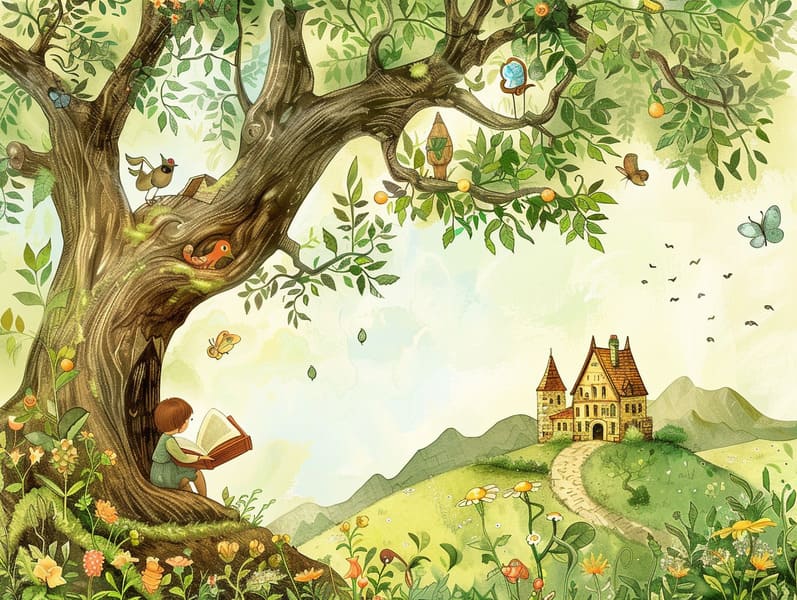The Formation of Legendary Fairy Tales with Their Lasting Loveliness.

Fairy tales for kids have legendary status. These stories have been relayed from one generation to the next millennia before they were ever written down. They emerged from a variety of cultures, including Asian traditions. They were initially disseminated among adults, often carrying themes and messages pertaining to the societal norms and beliefs of the time.
The famous Grimm duo, the two Grimm brothers, were among the first to gather many of these beloved tales. Their anthology, "Grimm's Fables," included stories like "Cinderella," "Little Brother and Little Sister," and "Snow White," which have since become hallmarks in the world of traditional fairy tales. Similarly, Hans Andersen's imaginative narratives, such as "The Mermaid," and "The Ugly Duckling," have stolen hearts worldwide, solidifying their place in the pantheon of beloved fairy tales.
Even though they are old, traditional fairy tales remain as relevant as ever, especially as children's bedtime stories. These delightful tales are now available in various formats, including artistically illustrated books, fantastical animations, and internet fairy tales.
Their lasting appeal can be connected to several fascinating points:
Valuable Lessons: Traditional fairy tales often share important moral lessons. Tales like "The Story of the Boy Who Cried Wolf" teach the virtue of sincerity, while "The Hare and the Tortoise" highlight the qualities of tenacity and humbleness. These stories offer children clear distinctions between right and wrong, shaping their moral compass in a mild yet profound way.
Warmth and Understanding: Traditional fairy tales frequently present figures facing difficulties and adversities, urging audiences to resonate with their struggles and back their triumphs. For instance, "Beauty and Her Beast" emphasizes the virtue of looking deeper to comprehend the true being of a being, developing awareness and insight.
Cultural Comprehension: Many old fairy tales are deeply embedded in the cultural contexts from which they sprang. Immersing in these fairy tales can provide enlightening views into different social structures, developing a sense of world respect and awareness.
Imagination and Creativity: The whimsical elements in old fairy tales—mythical entities—kindle children’s creative thoughts. These stories lead readers to fantasy realms, motivating fantastical thinking and a sense of mystery that lasts a lifetime.
Ancient fairy tales are not only entrancing but also edifying. They function as fascinating tools in advancing various cognitive and emotional skills in kids. When ancient fairy tales are read aloud, they strengthen linguistic abilities by offering new terms and meanings and complex sentence structures. This practice also cultivates listening skills and mental focus, as young ones listen intently, prepared to see what happens next.
Furthermore, talking about the themes and characters of ancient fairy tales can nurture cognitive skills and analytical skills. Children are taught to find patterns, forecast, and realize cause and effect. These explorations also ease little ones convey their thoughts and feelings, boosting their emotional intelligence.
In today’s technological era, the proliferation of internet fairy tales has made these narratives more acquirable than ever. Internet resources and software offer large libraries of bedtime fairy tales that can be viewed or listened to anytime, anywhere. Fairy tales recited are particularly widespread, presenting an enjoyable way for kids to take part in these enchanting tales. Read-aloud books and read-to-me stories bring characters and settings to life, often complemented by entrancing sound effects and harmonies that heighten the tale experience.
The lasting allure of old fairy tales lies in their ability to alter to current times while maintaining their central messages. Contemporary revisions of these fairy tales often include more varied characters and modern settings, making them relevant to today’s audience. However, the fundamental themes of spirit, humanity, and equity remain unchanged, continuing to strike a chord with audiences of all ages.
Fairy tales also offer a sense of peace and knowability. They furnish a well-arranged narrative with a obvious beginning, middle, and end, often drawing to a close with the wrap-up of conflicts and the triumph of goodness over badness. This consistency can be reassuring for little ones, affording a sense of unchangeability in an variable world.
Old fairy tales continue to spellbind and teach new generations, maintaining their appeal and importance in modern society. As children's night stories, they extend a perfect blend of captivation and insight, facilitating moral values, empathy, and creativity. The availability of online fairy tales and the likability of fairy tales read aloud confirm that these ancient stories remain reachable to new generations.
By maintaining and distributing these tales, we continue to extol the rich tapestry of cultural these guys heritage and cultural heritage. Whether you are enjoying a artistically illustrated book, accessing a internet collection, or listening to an sound book, the delight of children's fairy tales is always within reach. These narratives highlight of the continued strength of stories and its ability to join us across eras and regions.
Even if you are viewing a beautifully illustrated book, perusing a virtual library, or listening on an voice book, the splendor of Grimm's fairy tales is always within reach.
These narratives demonstrate of the steadfast effect of stories and its ability to bring us together across eras and regions, forming a connection that captivates and teaches alike.